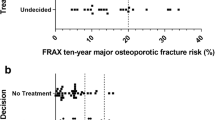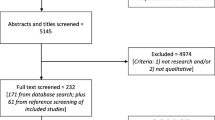Abstract
Background
There are effective treatments to prevent osteoporotic fractures, but these treatments are underutilized.
Objective
To evaluate the influence of patient characteristics, perceptions, knowledge and beliefs about osteoporosis on the decision to initiate osteoporotic treatment.
Participants
We identified female members of a managed care plan who had a dual energy x-ray absorptiometry (DXA) bone density test and fulfilled World Health Organization criteria for osteoporosis. Patients were excluded if they received osteoporotic medications in the prior 6 months.
Measurements
Patients were sent a questionnaire that included items assessing satisfaction with physician–patient communication, trust in the physician, osteoporosis knowledge and beliefs, beliefs about prescription medications, and perceptions of barriers to medication use. Administrative electronic health records were used to identify prescription drug use and health care utilization.
Results
Two hundred and thirty-six women returned surveys and research authorization forms out of 465 contacted for participation. One hundred and thirty-five (57.2%) filled a prescription for an osteoporotic drug in the first 3 months after the DXA exam. The largest differences between initiators and non-initiators were in beliefs in the benefits of medications, and distrust of medications, with initiators believing more strongly in the benefits and effectiveness of medications (p < .001), and non-initiators reporting more distrust of medications (p < .001). Osteoporosis knowledge and the belief that osteoporosis is a serious disease were also related to therapy initiation in bivariate analysis.
Conclusions
Only 57% of patients initiated osteoporotic medication within 3 months of diagnosis. The decision to start osteoporosis treatment appeared to be related to a patient’s beliefs in the effectiveness of osteoporosis medications and distrust of medications.
Similar content being viewed by others
References
National Committee for Quality Assurance. Medicare HEDIS 2006 means, percentiles and ratios. http://www.ncqa.org/tabid/494/Default.aspx. Accessed August 15, 2008.
McCombs JS, Thiebaud P, McLaughlin-Miley C, Shi J. Compliance with drug therapies for the treatment and prevention of osteoporosis. Maturitas. 2004;48:271–287.
Tosteson AN, Grove MR, Hammond CS, Moncur MM, Ray GT, Hebert GM, Pressman AR, Ettinger B. Early discontinuation of treatment for osteoporosis. Am J Med. 2003;115:209–216.
Papaioannou A, Kennedy CC, Dolovich L, Lau E, Adachi JD. Patient adherence to osteoporosis medications; problems, consequences and management strategies. Drugs Aging. 2007;24:37–55.
Solomon DH, Avorn J, Katz JN, Finkelstein JS, Arnold M, Polinski JM, Brookhart MA. Compliance with osteoporosis medications. Arch Intern Med. 2005;165:2414–2419.
Siris ES, Harris ST, Rosen CJ, Barr CE, Arvesen JN, Abbott TA, Silverman S. Adherence to bisphosphonate therapy and fracture rates in osteoporotic women: relationship to vertebral and nonvertebral fractures from 2 US claims databases. Mayo Clin Proc. 2006;81:1013–1022.
Caro JJ, Ishak KJ, Huybrechts KF, Raggio G, Naujoks C. The impact of compliance with osteoporosis therapy on fracture rates in actual practice. Osteoporos Int. 2004;15:1003–1008.
Huybrechts KF, Ishak KJ, Caro JJ. Assessment of compliance with osteoporosis treatment and its consequences in a managed care population. Bone. 2006;38:922–928.
Briesacher BA, Andrade SE, Yood RA, Kahler KH. Consequences of poor compliance with bisphosphonates. Bone. 2007;41:882–887.
Haynes RB, McKibbon KA, Kanani R. Systematic review of randomized trials of interventions to assist patients to follow prescriptions for medications. Lancet. 1996;348:383–386. erratum Lancet 1997;349:1180.
Heidenreich PA. Patient adherence: the next frontier in quality improvement. Am J Med. 2004;117:130–132.
Peterson AM, Takiya L, Finley R. Meta-analysis of trials of interventions to improve medication adherence. Am J Health Syst Pharm. 2003;60:657–665.
Vermeire E, Hearnshaw H, Van Royen P, Denekens J. Patient adherence to treatment: three decades of research. A comprehensive review. J Clin Pharm Ther. 2001;26:331–342.
Osterberg L, Blaschke T. Adherence to medication. N Engl J Med. 2005;353:487–497.
Brookhart MA, Avorn J, Katz JN, Finkelstein JS, Arnold M, Polinski JM, Patrick AR, Mogun H, Solomon DH. Gaps in treatment among users of osteoporosis medications: The dynamics of noncompliance. Am J Med. 2007;120:251–256.
Yood RA, Emani S, Reed JI, Lewis BE, Charpentier M, Lydick E. Compliance with pharmacologic therapy for osteoporosis. Osteoporos Int. 2003;14:965–968.
Badamgarav E, Fitzpatrick LA. A new look at osteoporosis outcomes: The influence of treatment, compliance, persistence, and adherence. Mayo Clin Proc. 2006;81:1009–1012.
Unson CG, Siccion E, Gaztambide J, Gaztambide S, Mahoney Trella P, Prestwood K. Nonadherence and osteoporosis treatment preferences of older women: a qualitative study. J Womens Health (Larchmt). 2003;12:1037–1045.
Weiss TW, Gold DT, Silverman SL, McHorney CA. An evaluation of patient preferences for osteoporosis medication attributes: Results form the PREFER US Study. Curr Med Res Opin. 2006;22:949–960.
Johnson MJ. The medication adherence model: a guide for assessing medication taking. Res Theory Nurse Pract. 2002;16:179–192.
Dowell J, Hudson H. A qualitative study of medication-taking behaviour in primary care. Fam Prac. 1997;14:369–375.
Benson J, Britten N. Patients’ decisions about whether or not to take antihypertensive drugs: Qualitative study. BMJ. 2002;325:873.
Pound P, Britten N, Morgan M, Yardley L, Pope C, Daker-White G, Campbell R. Resisting medicines: A synthesis of qualitative studies on medicine taking. Soc Sci Med. 2005;61:133–155.
Svensson S, Kjellgren KI, Ahlner J, Saljo R. Reasons for adherence with antihypertensive medication. Int J Cardiol. 2000;76:157–163.
DiMatteo MR, Haskard KB, Williams SL. Health beliefs, disease severity, and patient adherence. A meta-analysis. Med Care. 2007;45:521–528.
Cline RR, Farley JF, Hansen RA, Schommer JC. Osteoporosis beliefs and antiresorptive medication use. Maturitas. 2005;50:196–208.
Charlson ME, Pompei P, Ales KL, MacKenzie CR. A new method of classifying prognostic comorbidity in longitudinal studies; Development and validation. J Chronic Dis. 1987;40:373–383.
Deyo RA, Cherkin DC, Ciol MA. Adapting a clinical comorbidity index for use with ICD-9-CM administrative databases. J Clin Epidemiol. 1992;45:613–619.
American Board of Internal Medicine. Final report on the patient satisfaction questionnaire project. Washington DC. 1989.
Dugan E, Trachtenberg F, Hall MA. Development of abbreviated measures to assess patient trust in a physician, a health insurer, and the medical profession. BMC Health Serv Res. 2005;5:64.
Werner P. Knowledge about osteoporosis: Assessment, correlates and outcomes. Osteoporos Int. 2005;16:115–127.
Mazor KM, Fischer MA, Billings-Gagliardi S. Initial acceptance of treatment with antihypertensive medication: the importance of communication, trust and beliefs. J Commun Healthcare. 2008;1:311–323.
Brookhart MA, Patrick AR, Schneeweiss S, Avorn J, Dormuth C, Shrank W, van Wijk BL, Cadarette SM, Canning CF, Solomon DH. Physician follow-up and provider continuity are associated with long-term medication adherence: a study of the dynamics of statin use. Arch Intern Med. 2007;167:847–852.
Brookhart MA, Patrick AR, Dormuth C, Avorn J, Shrank W, Cadarette SM, Solomon DH. Adherence to lipid-lowering therapy and the use of preventive health services: An investigation of the healthy user effect. Am J Epidemiol. 2007;166:348–354.
Rossini M, Bianchi G, Di Munno O, Giannini S, Minisola S, Sinigaglia L, Adami S. Treatment of osteoporosis in clinical practice (TOP) study group. Determinants of adherence to osteoporosis in clinical practice. Osteoporos Int. 2006;17:914–921.
Segal E, Tamir A, Ish-Shalom S. Compliance of osteoporotic patients with different treatment regimens. Isr Med Assoc J. 2003;5:859–862.
Fraenkel L, Gulanski B, Wittink D. Patient treatment preferences for osteoporosis. Arthritis Rheum. 2006;55:729–735.
Acknowledgment
The authors thank Brooke Harrow PhD for helpful review of the manuscript.
Conflicts of interest
This study was funded by a grant from Novartis Pharmaceuticals Corporation. Robert Yood has received financial support from Merck for pharmaceutical drug trials, from Novartis for a research study, and from Procter and Gamble for consultancy. Merck, Novartis, and Procter and Gamble are makers of drugs for the treatment of osteoporosis. Kathleen Mazor has no potential conflicts of interest to report. Susan Andrade has received financial support (through grants and consultancies) from Merck and Novartis. Srinivas Emani has no potential conflicts of interest to report. Wing Chan and Kristijan Kahler are employees of Novartis.
Author information
Authors and Affiliations
Corresponding author
Rights and permissions
About this article
Cite this article
Yood, R.A., Mazor, K.M., Andrade, S.E. et al. Patient Decision to Initiate Therapy for Osteoporosis: The Influence of Knowledge and Beliefs. J GEN INTERN MED 23, 1815–1821 (2008). https://doi.org/10.1007/s11606-008-0772-0
Received:
Revised:
Accepted:
Published:
Issue Date:
DOI: https://doi.org/10.1007/s11606-008-0772-0




